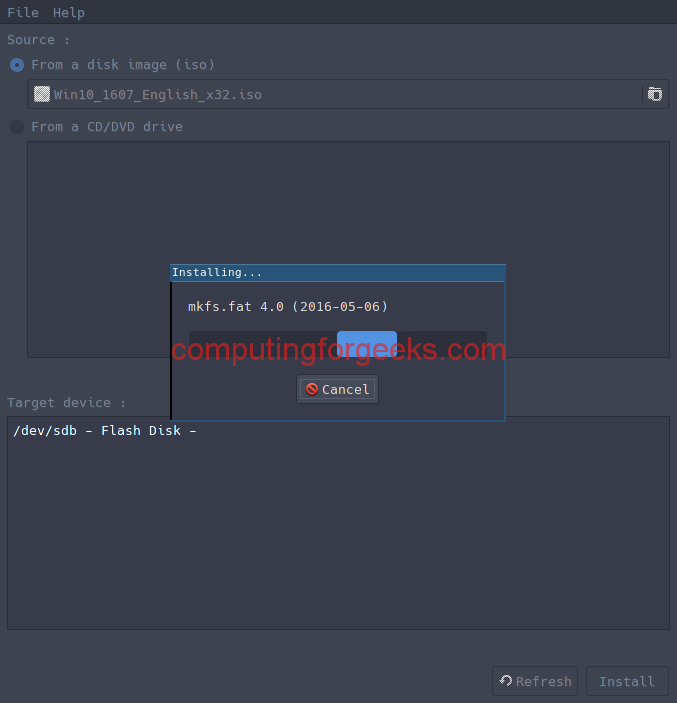
Grub Boot Code Meant To
WoeUSBuses GRUB for BIOS Boot. In fact, this is the ideal way to dual boot Windows and Linux.This mode does not support Secure Boot (uefi-ntfs bootloader is not signed by Microsoft or other trusted party). For many users, Windows 10 installed first will be the likely configuration. NeoGrub was added in EasyBCD 1.51 as experimental-only code meant to explore the possibilities and provide temporary workaround for some commonly-encountered problems.Dual Boot Linux with Windows 10 Windows Installed First. Rescatux Fixes GRUB / GRUB2 Many UEFI boot options Check and fix filesystems Clear Windows password Change Gnu/Linux password Regenerate sudoers file And much more features How to put Rescatux into a CDROM or a USB 672 MB Size Super Grub2 Disk Boots into many systems and GRUB2 ones Helps you to fix your GRUB or Continue reading Home Think of NeoGrub as EasyBCD’s “magic bootloader” – it’s an implementation of a bootloader within a bootloader that makes it possible to script and automate certain system startup task that would never have been possible with just the BCD alone.
It even lets you load Windows in ways that the BCD bootloader makes quite impossible! What NeoGrub Can be Used ForNeoGrub has infinite number of possible usages – the sky truly is the limit thanks to the scriptable boot process and chainloading support. To date, NeoGrub has played a major role in getting non-compliant, buggy, and out-dated operating systems to boot with Windows Vista – along with a number of other nifty tricks that couldn’t be done otherwise. Finally you have to boot on a Linux live DVD/USB to re-install Grub (the boot loader) as.With EasyBCD 1.7, NeoGrub was completely overhauled, with full-quality standards-compliant code and behavior, with support for more platforms and filesystems – and is several times more powerful than the original. This script uses: lsblk and sfdisk from util-linuxThe first step is obvious: obtaining the Windows 10 ISO file. VentoyBooting multi-tool with brilliant support of Windows ISO direct loading.
Chainloading other Linux bootloaders such as GRUB2, LILO, and more.As of EasyBCD 1.7, most of NeoGrub’s limitations have been lifted and it can now be used in the same exact way as a standard GRUB bootloader except that it has added support for some Windows-specific features and can read/load from an NTFS-based partition. Hiding partitions from one-another at boot time Installing, configuring, and maintaining the GRUB bootloader from within Windows – no Live CDs, Super Grub Disks, or Linux installations required.
Configuring NeoGrubOnce you’ve added NeoGrub to the BCD bootloader, when you go back to the “Add Entry” screen, the option to install NeoGrub should no longer be there. At the moment, NeoGrub doesn’t do anything, you have to configure it to do what you need. Wait for the “Installation Complete” notification.You should now have an entry “NeoGrub” in the Vista bootloader – but the catch is, it’s useless. Navigate to the “NeoGrub” tab in the “Add an Entry” section. The hard part is scripting NeoGrub to do what you need it to…
Once you’ve found it, make this partition the root of our console. Search for NTLDR in the / directory of all partitions that you can read. Single-Entry menu.lstBasic NeoGrub file: # NeoSmart NeoGrub Bootloader Configuration File# This NeoGrub menu.lst file should be located at \NST\menu.lst of the boot drive.# Please see the EasyBCD Documentation for information on how to create/modify entriesWith the sample menu.lst contents above, when you pick NeoGrub from the bcd/bootmgr bootloader, it would load up menu.lst and follow it step-by-step: It consists of lines read & processed in the order they appear. You can edit this menu file in any text editor, we recommend the freeware, open-source Notepad++.Menu.lst is basically a script in the GRUB language. This is where we do all our hacking to make operating systems work, drives disappear, and the magic happen.NeoGrub uses the same syntax as its parent bootloaders, GRUB and Grub4Dos.
Once found, use that partition as root.Makeactive #Make this the active partitionChainloader /NTLDR #Run NTLDR, the Windows XP bootloader#If we're using a menu, we don't need to use the `boot` command - it's automatically implied.Root (hd1,2) #Load Ubuntu from the 2nd harddrive's 3rd partition.#Next Line: Translate (hd1,2) to Linux notation and set that as the root partitionKernel /boot/vmlinuz-2.6.22-14-generic root=/dev/sdbcInitrd /boot/initrd.img-2.6.22-14-genericGiven the sample file above, NeoGrub would display a menu with two entries (“Load Windows XP” and “Load Ubuntu Gutsy Gibbon”). Comments are prefixed with a '#'Default 0 #Pick the task to be run if the user doesn't pick one within the time limit.Timeout 10 #Give the user 10 seconds to choose a task.#We use the "title" keyword to indicate a new entry in the menu.Title Windows XP #This is our first entry - it's number 0Find -set-root /NTLDR #Search for NTLDR on all partitions. It’ll give you a list of tasks to pick from, and you choose the one you want.Sample multi-entry NeoGrub file: # NeoSmart NeoGrub Bootloader Configuration File#This is a comment. This way, you can take advantage of NeoGrub’s features to do more than one thing. (In this case, it’ll boot by completing the previous chainload command and calling NTLDR.)You can also have NeoGrub display a list of choices when you select it from the Vista bootloader. Chainload (hand-off the boot process) to the Windows XP bootloader that is called NTLDR and located in the / directory of our current root drive.




 0 kommentar(er)
0 kommentar(er)
